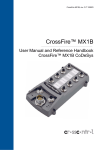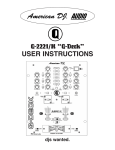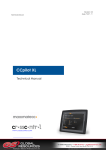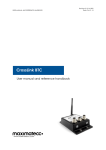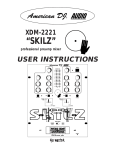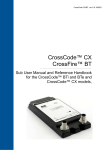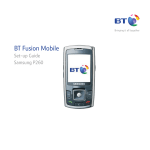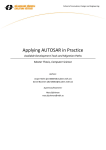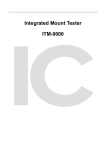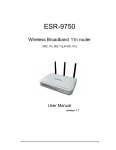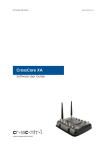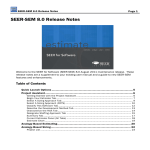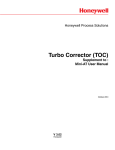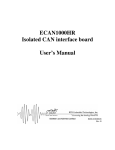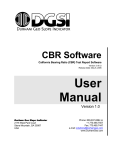Download CrossFire™ MX1B - maximatecc support
Transcript
CrossFire MX1b, rev. D.7 100823 CrossFire™ MX1B User Manual and Reference Handbook CrossFire™ MX1B CANopen slave User Manual and Reference Handbook CrossFire™ MX1B CANopen slave Table of Contents Introduction .............................................................................................................................................................. 3 Functions and Features ...................................................................................................................................... 4 Technical data .................................................................................................................................................... 5 References ......................................................................................................................................................... 6 Weight and dimensions....................................................................................................................................... 6 Identification........................................................................................................................................................ 7 Environmental Tolerance .................................................................................................................................... 7 Installation........................................................................................................................................................... 7 Electrical Interface ................................................................................................................................................... 8 Connectors ......................................................................................................................................................... 8 Electrical Interface Overview ............................................................................................................................ 12 Electrical Interface Characteristics .................................................................................................................... 13 LED indicators .................................................................................................................................................. 18 Appendix 1 – Environmental Tolerances ............................................................................................................... 19 Technical Support .................................................................................................................................................. 20 Trade Mark, etc. .................................................................................................................................................... 21 Index ...................................................................................................................................................................... 22 2 User Manual and Reference Handbook CrossFire™ MX1B CANopen slave CrossFire™ MX1B Introduction The CrossFire™ MX1B is a general, flexible I/O module and controller for rough environments. It fits in distributed and decentralized systems where you want to be able to put electronics close to the I/O that will be managed. The module is highly configurable, and has its I/O distributed over a number of M12 connectors. The CrossFire™ MX1B is a CAN bus node, and by configuring the node properties, the module can be set up to automatically send and receive I/O to and from the CAN bus network. The CrossFire™ MX1B supports the CANopen protocol which is one of the leading protocols used for CAN bus networks. This document describes how the CrossFire™ MX1B CANopen slave should be used. The reader should be familiar with the CANopen standard in order to fully understand the manual. 3 User Manual and Reference Handbook CrossFire™ MX1B CANopen slave Functions and Features The CrossFire™ MX1B is a CiA DS-401 I/O (Input/output) module, designed for automotive products equipped with hydraulic components. It has 20 individually configurable I/O ports to provide various types of I/O. The CrossFire™ MX1B can therefore be configured to have: - Up to 12 Digital ON/OFF Outputs (PNP Open-Emitter) - Up to 12 Digital Inputs - Up to 12 Analog Inputs - 8 of which have two software-selectable ranges, 0–5 V or 0–32 V - Up to 8 Regulated PWM (Pulse Width Modulated) Outputs - Up to 4 Non-Regulated PWM Outputs - Up to 2 Pulse Counter Inputs or 1 pair of Shaft Encoder Inputs - Up to 2 Frequency Measurement inputs Configurable using SDO’s (Service Data Object) 8 dynamically-mapped PDO’s (Process Data Objects) compliant to DS-401 Supports use of synch object Support for both heartbeat and node guarding The CrossFire™ MX1B is an EMCY (Emergency) object producer. The COB ID (Communication Object Identifier) of the EMCY object can be configured Storage for up to 127 Error codes Status bits for output drivers (“Ok”, “short circuit”, “open load” or “over current”) are sent directly with TPDO1, (i.e. there is no need to request them with an SDO) Reset function restores settings back to their factory default values CANopen Node ID is hardware-configurable by means of a dongle, or may be configured using SDO’s 4 User Manual and Reference Handbook CrossFire™ MX1B CANopen slave Technical data Processor Infineon C167 Physical Housing Dimensions Weight Plastic enclosure filled with silicon compound, metal base plate L x W x H: 212 x 116 x 37 mm (H = 67 mm with connectors) 1.0 kg. Environment Operating Temperature Range Protection rating Protection Class EMC Conformity -40 ˚C to +85 ˚C IP67 (IEC 60529) III ISO 14982 for Emissions, ISO 11452-2 for Immunity Power Supply Operating voltage Current consumption 10 to 36 VDC <100 mA at 24 V without external load Indicators PS: Power, CAN interface Communication profile Device Profile Drivers Baud Rate Node ID ISO 11898-2 (High Speed CAN) CANopen I/O module to CiA DS401 Phillips 82C251 or 82C252 10, 20, 50, 100, 125, 250, 500, 800 and 1000 kbit/s 1 to 16 hardware set, or 1 to 127 set with SDO’s Serial Interface RS-232 (Only for firmware loading, not for application) Connectors I/O: DIN M12 Digital Inputs Input Voltage Pulse Shaft Encoder Inputs 0 – 5 V, 0 – 24 V Frequency up to 60 kHz. Full quadrature decoding Analog Inputs* Input Voltage Input impedance Resolution Total Unadjusted Error 0 – 5 V, 0 – 32 V or 0 – 20 mA 1 MΩ (0 – 5 V), 11.5 kΩ (0 – 32 V) 10 bits ±2 LSB’s Digital Outputs Max Voltage Max Current Total Current Protection 30 V 3A 18 A (external fuse not included) Ground Fault, Over Current, Open Load, with Status Feedback PWM (Analog) Outputs Max Voltage Max Current Resolution Protection 30 V 3A 0.1 % Ground Fault, Over Current, Open Load, with Status Feedback ST: CAN status, CAN: DIN M12 CAN: CANopen status Power: DIN M23 Certifications / Compliance *The analog inputs that are combined with on/off outputs shall only be used as feedback for the outputs. Because of the open-load detection feature there will be a low current flowing to these outputs. This makes the inputs not useful as ordinary analog inputs 5 User Manual and Reference Handbook CrossFire™ MX1B CANopen slave References CAN in Automation - CANopen standard: CE Marking: International Standards Organisation: International Electrotechnical Commission http://www.can-cia.org http://ec.europa.eu/ http://www.iso.org/ http://www.iec.ch/ Weight and dimensions Ø4 (4x) 17 44.7 The CrossFire™ MX1B dimensions and placement of the four mounting holes is illustrated below. The four mounting lugs have clearance for 4 mm bolts. The module weighs 1.0 kg. 160 116 100 104 Ø4 (4x) 212 6 User Manual and Reference Handbook CrossFire™ MX1B CANopen slave Identification There is a label on the back of the CrossFire™ MX1B. On the label there are numbers which identify your unique module. Take note of them. During service and other contact with the supplier it is important to be able to provide these numbers. Environmental Tolerance The CrossFire™ MX1B has been designed to cope with tough environmental demands. Strict tests have been conducted on the unit in order to ensure that it fulfils the expectations of a rugged unit. Much work has been performed to choose and design integral components so that they, in the best possible way and under all circumstances, provide you with a dependable working instrument. In Appendix 1, a list of standards can be found according to which the CrossFire™ MX1B has been tested and approved. Despite thorough design requirements and testing specifications, it is always best to install and handle the CrossFire™ MX1B with care. Installation Your CrossFire™ MX1B should be installed in such a way that the module is not exposed to any unnecessary stress, heat, vibration or moisture. In this section, some recommendations are made regarding methods for how the unit should be installed. If the unit is opened by non-authorised personnel, the warranty becomes invalid. Cooling Although the CrossFire™ MX1B can operate in relatively high temperatures, cooling should still be considered when installing the CrossFire™ MX1B. If the unit becomes too warm, it may not perform to its full capacity and, with high temperature, cease to function. Common sense should be used to select an appropriate location where adequate cooling is achievable. It is not recommended to install the module near a vehicle’s exhaust system, for example. Inadequate cooling may lead to overheating, causing permanent damage to the unit. Vibration We recommend installing the CrossFire™ MX1B in such a way that it is not unnecessarily exposed to vibration or other stress. Rain / Moisture The CrossFire™ MX1B shall preferably be placed under a roof in order to prevent direct exposure to water. 7 User Manual and Reference Handbook CrossFire™ MX1B CANopen slave CrossFire™ MX1B Electrical Interface Connectors Every I/O pin on the CrossFire™ MX1B is assigned a unique port. The ports are numbered from 1 to 20. Every port may be configured individually in software to one of 6 different I/O types. Not all I/O types are available on all ports. In some cases, a port is associated with more than one pin. This occurs when two or more pins work together to perform a certain function. Connector 1 Pin Port Default Signal Other Configurations X1.1 X1.2 X1.3 X1.4 2 1 2 1 Regulated PWM Output Current Feedback Current Feedback Regulated PWM Output Digital ON/OFF Output Type 1 X1.5 - GND GND Pin Port Default Signal Other Configurations X2.1 X2.2 X2.3 X2.4 4 3 4 3 Regulated PWM Output Current Feedback Current Feedback Regulated PWM Output Digital ON/OFF Output Type 1 X2.5 - GND GND Pin Port Default Signal Other Configurations X3.1 - +5V ref X3.2 X3.3 9 - Analog Input Type 1 Analog GND DIN M12 female, 5-pole Digital ON/OFF Output Type 1 Connector 2 DIN M12 female, 5-pole Digital ON/OFF Output Type 1 Connector 3 X3.4 13 Analog Input Type 2* X3.5 - GND Digital Input Type 1 (0-5/0-32 V) DIN M12 female, 5-pole Digital ON/OFF Output Type 2 Digital Input Type 2 (0-5/0-32 V) PWM Output (non-regulated) Pulse Counter / Encoder A Input Frequency Measurement GND 8 User Manual and Reference Handbook CrossFire™ MX1B CANopen slave Connector 4 Pin Port Default Signal Other Configurations X4.1 X4.2 X4.3 10 - +5V ref Analog Input Type 1 Analog GND Digital Input Type 1 (0-5/0-32 V) X4.4 14 Analog Input Type 2* X4.5 - GND Digital ON/OFF Output Type 2 Digital Input Type 2 (0-5/0-32 V) PWM Output (non-regulated) Pulse Counter / Encoder B Input Frequency Measurement GND Pin Port Default Signal Other Configurations X5.1 X5.2 X5.3 12 - +5V ref Analog Input Type 1 Analog GND Digital Input Type 1 (0-5/0-32 V) X5.4 16 Analog Input Type 2* X5.5 - GND Digital ON/OFF Output Type 2 Digital Input Type 2 (0-5/0-32 V) PWM Output (non-regulated) GND Pin Port Default Signal Other Configurations X6.1 X6.2 X6.3 11 - +5V ref Analog Input Type 1 Analog GND Digital Input Type 1 (0-5/0-32 V) X6.4 15 Analog Input Type 2* X6.5 - GND DIN M12 female, 5-pole Connector 5 DIN M12 female, 5-pole Connector 6 DIN M12 female, 5-pole Digital ON/OFF Output Type 2 Digital Input Type 2 (0-5/0-32 V) PWM Output (non-regulated) GND *The analog inputs that are combined with on/off outputs shall only be used as feedback for the outputs. Because of the open-load detection feature there will be a low current flowing to these outputs. This makes the inputs not useful as ordinary analog inputs. Connector 7 Pin Port Default Signal Other Configurations X7.1 X7.2 X7.3 X7.4 X7.5 6 5 6 5 - Regulated PWM Output Current Feedback Current Feedback Regulated PWM Output GND Digital ON/OFF Output Type 1 DIN M12 female, 5-pole Digital ON/OFF Output Type 1 GND 9 User Manual and Reference Handbook CrossFire™ MX1B CANopen slave Connector 8 Pin Port Default Signal Other Configurations X8.1 X8.2 X8.3 X8.4 X8.5 8 7 8 7 - Regulated PWM Output Current Feedback Current Feedback Regulated PWM Output GND Digital ON/OFF Output Type 1 DIN M12 female, 5-pole Digital ON/OFF Output Type 1 GND CAN Connector Pin Port Default Signal CAN.1 CAN.2 CAN.3 CAN.4 - No Connection No Connection CANGND CANH CAN.5 - CANL Comments DIN M12 male, 5-pole DIN M23 male, 7-pole Power Supply (PS) Connector Pin Port Default Signal Comments PS.1 PS.2 PS.3 PS.4 PS.5 PS.6 - +24 V +24 V GND GND TxD RxD 10 V-36 V supply (Vbatt) Load-dump protection. Standard RS-232 levels (±10 V) Standard RS-232 levels (±10 V) PS.7 - Debug Used for program loading Other Configurations Battery ground 6 7 5 1 4 2 3 ID Connector Pin Port Default Signal ID.1 19 ID2 ID.2 18 ID1 ID.3 - GND ID.4 17 ID0 ID.5 20 ID3 Digital Input Type 3 (0-5 V) Analog Input Type 3 Digital Input Type 3 (0-5 V) Analog Input Type 3 Digital Input Type 3 (0-5 V) Analog Input Type 3 Digital Input Type 3 (0-5 V) Analog Input Type 3 DIN M12 x 1 male, 5-pole 10 User Manual and Reference Handbook CrossFire™ MX1B CANopen slave ID Interface Lookup Table CANopen Node ID ID3 ID2 ID1 ID0 1 2 3 4 …. 0 0 0 0 0 0 0 0 0 0 1 1 0 1 0 1 16 1 1 1 1 State 0 is reached by wiring corresponding ID pin to pin 3 (GND) State 1 is reached by leaving corresponding ID pin disconnected. Notice that the connector descriptions are those which are located on the unit, not those that the attached cables shall have in order to mate with them. Use caution when plugging/unplugging connectors. If the pins become bent or damaged they may not function correctly, or in the worst case, the CrossFire™ MX1B or other equipment may be damaged. 11 User Manual and Reference Handbook CrossFire™ MX1B CANopen slave Electrical Interface Overview The CrossFire™ MX1B is highly configurable. The following illustration consists of several boxes which represent the main functional groups on the CrossFire™ MX1B. The arrows leading to and from the functional groups represent I/O, power or communication busses. The configuration can be changed by writing to the object dictionary in the Manufacturer-Specific Profile Area (0x2000 to 0x5FFF). CrossFire MX1B Analog Inputs Type 1 4 Ports (9 – 12) Each channel with range selection: 0 to 5 V 0 to 32 V* 0 to 20mA** Also configurable as: • 4 Digital inputs Digital Inputs There can be as many as 12 Digital Inputs, available only when other ports are configured as Digital Inputs ID Interface 4 Ports (17 – 20) Possible Node ID 1 to 16 (1 to 127 can be set in s/w) Regulated PWM Outputs Current regulation automatically performed in H/W Also configurable as: • 8 Digital ON/OFF Outputs Mixed I/O Analog Inputs Type 2*** Configurable as: • 4 Analog Inputs (default) • 4 Digital Inputs • 4 Digital Outputs • 4 PWM Outputs (non-regulated) +24 Vbatt 4 Ports (13 –16) Ports 13 and 14 also configurable as: • 2 Pulse Counters • 1 Shaft Decoder • 2 Frequency Inputs CAN Interface Also configurable as: • 4 Digital Inputs • 4 Analog Inputs Power 8 Ports (1 - 8) 1 CAN BUS Serial Interface RS-232 * not available on Analog Input Ports 17, 18, 19 or 20 **with external 250 Ω resistor *** The analog inputs that are combined with on/off outputs shall only be used as feedback for the outputs. Because of the open-load detection feature there will be a low current flowing to these outputs. This makes the inputs not useful as ordinary analog inputs. 12 User Manual and Reference Handbook CrossFire™ MX1B CANopen slave Electrical Interface Characteristics Analog Inputs There are three types of Analog Inputs available on the CrossFire™ MX1B. Only ports 9 through 16 are configured by default. Ports 17 through 20 must be reconfigured in the object dictionary (index 0x2000) in order to be used as Analog Inputs. The port allocations and characteristics of all Analog Inputs are described in the tables below. Analog Inputs Port 9 10 11 12 13 14 15 16 17 18 19 20 Signal Type Comment Analog Input Type 1 Functional Group: Analog Inputs Analog Input Type 2 Functional Group: Mixed I/O Analog Input Type 3 Functional Group: ID Interface Electrical Characteristics for Analog Inputs Value Signal Name Parameter Analog Input Type 1 Analog Input Type 2* Input Voltage Analog Input Type 3 Analog Inputs Types 1, 2 & 3 Input Impedance 0 – 32 volt range Typ Max Unit - 5/32 V 0 - 5/32 or Vbatt V 0 - 5 V 0 Analog Input Type 3 Analog Input Type 1 and 2 Min Comment Each port has a softwareselectable range Each port has a softwareselectable range Damage Occurs if Input Voltage exceeds Vbatt 10 kΩ pull-up to +5 V 11.5 kΩ pull down* Input Impedance 0 – 5 volt range 1 MΩ pull down 10 kΩ pull up Resolution 10 bits Total Unadj.Error ±2 LSB Input Capacitance 100 nF Protection 0 – 5 volt range* Diode-Clamp protected against over- and under voltage. *Use of 0 – 32 Volt range adversely affects input impedance and error. *The analog inputs that are combined with on/off outputs shall only be used as feedback for the outputs. Because of the open-load detection feature there will be a low current flowing to these outputs. This makes the inputs not useful as ordinary analog inputs. 13 User Manual and Reference Handbook CrossFire™ MX1B CANopen slave Digital Inputs There are three types of Digital Inputs available on the CrossFire™ MX1B. Only ports 17 to 20, however, are available by default. The desired ports must therefore be reconfigured as Digital Inputs in order to be used (See object dictionary, index 0x2000). The port allocations and characteristics of all Digital Inputs are described in the tables below. Digital Inputs Port 9 10 11 12 13 14 15 16 17 18 19 20 Signal Name Comment Digital Input Type 1 Functional Group: Analog Inputs Digital Input Type 2 Functional Group: Mixed I/O Digital Input Type 3 Functional Group: ID Interface Digital Input Types 1 and 2 have a software selectable voltage range, and a 1-MΩ pull down resistor. All inputs are diode clamp protected against over- and under voltage. Electrical Characteristics for Digital Inputs Signal Name Parameter Digital Input Type 1 Digital Input Type 2 Digital Input Type 3 Min 0 Input Voltage Digital Input Type 3 Digital Input Types 1 and 2 Value 0 Typ Max Input Impedance 0 - 5 volt range Comment Each port has a softwareselectable range Each port has a softwareselectable range Damage Occurs if Input Voltage exceeds Vbatt - 5/32 V - 5/32 or Vbatt V 5 V 10 kΩ pull-up to +5 V 11.5 kΩ pull down 1 MΩ pull down 10 kΩ pull up 0 Input Impedance 0 – 32 volt range Unit 14 User Manual and Reference Handbook CrossFire™ MX1B CANopen slave Digital ON/OFF Outputs There are two types of Digital ON/OFF Outputs, both of which can drive currents up to 3.0 Amps at 24 volts. None of the ports are configured as Digital Outputs by default, and must therefore be configured in the object dictionary (index 0x2000) in order to be used. The port allocation and characteristics are described in the following tables. Digital ON/OFF Outputs Port 1 2 3 4 5 6 7 8 13 14 15 16 Signal Name Comment Digital ON/OFF Output Type 1 Functional Group: Regulated PWM Outputs Digital ON/OFF Output Type 2 Functional Group: Mixed I/O Electrical Characteristics for Digital ON/OFF Outputs Value Signal Name Parameter Output Voltage Digital ON/OFF Output Type 1 and Type 2 Output Current Min 0 Typ Max 24 30 3.0 Unit Comment V Outputs shut down @ 30 V A Protected against short circuit to gnd, open load and overload (3.0 A) Status can be read in software Open load and short circuit detection The open load detection is active during the first 250 ms after start up of the MX1B unit. An open load state can only be detected if the output is turned off, which is the default state at start up. According to the configuration possibilities for port 13-16 the open load detection might not be reliable. Therefore it is not recommended to use the open load detection feature for port 13-16. The short circuit detection is active when an output is turned on. If a short circuit state is detected then the corresponding port will be disabled and prevented to be turned on again. The port will be disabled until the problem is solved and the power supply of MX1B is reset. 15 User Manual and Reference Handbook CrossFire™ MX1B CANopen slave PWM Outputs (Regulated & Non-Regulated) There are two types of PWM outputs, namely Regulated and Non-Regulated PWM Outputs. The Non-regulated PWM Outputs are not enabled by default. In order to enable them, the corresponding ports must be configured as Analog Outputs by writing an SDO to the object dictionary (address 0x2000). The following tables show the port allocations and characteristics of the PWM Outputs. PWM Outputs Port 1 2 3 4 5 6 7 8 9 10 11 12 Signal Name Comment Current Regulation is performed automatically in hardware. Regulated PWM Output Must have inductive load (Non-Regulated) PWM Output No current regulation Electrical Characteristics for PWM Outputs Value Signal Name Parameter Output Voltage Regulated and Non-Regulated PWM Output Min 0 Typ Max 24 Output Current 30 3.0 Unit Comment V Outputs shut down @ 30 V A Protected against short circuit to GND, open load and overcurrent (3.0 A) Status can be read in software Output Frequency Duty Cycle Range 10 0 - kHz 100 % Corresponds to 0 – 1023 in Software. Open load and short circuit detection The open load detection is active during the first 250 ms after start up of the MX1B unit. An open load state can only be detected if the output is turned off, which is the default state at start up. The short circuit detection is active when an output is turned on. If a short circuit state is detected then the corresponding port will be disabled and prevented to be turned on again. The port will be disabled until the problem is solved and the power supply of MX1B is reset. 16 User Manual and Reference Handbook CrossFire™ MX1B CANopen slave Pulse Counter / Shaft Encoder Inputs / Frequency Measurement The Pulse Counter, Frequency Measurement and Shaft Encoder characteristics are electrically identical – the only difference being how the signals are interpreted in software – so they are grouped together here for simplicity. By default, these Inputs are not available. In order to use these inputs, reconfigure the ports in the object dictionary at index 0x2000. The following tables describe the port allocations and characteristics of the PWM Outputs. Note that both ports are required to read a single Shaft Encoder. Pulse Counter / Shaft Encoder Inputs / Frequency Measurement Port 13 14 Signal Name Comment Pulse Counter Shaft Encoder A Frequency Measurement Pulse Counter Shaft Encoder B Frequency Measurement Functional Group: Mixed I/O Electrical Characteristics for Pulse Counter / Shaft Encoder Inputs / Frequency Measurement Value Signal Name Pulse Counter FrequencyMeasurement Shaft Encoder Parameter Min Input Voltage 0 Frequency 0 Unit Comment 5/24 V Software selectable input voltage range. 60 kHz Interrupt driven. Typ Max - Power Interface Power Interface Electrical Characteristics Value Parameter Unit Min Typ Max Supply Voltage, Vbatt 10 24 36 V Supply Current 0.1 - 18 A Comment Outputs disabled @ 30 V Load-dump protected @ 40 V External 18-A fuse required. 17 User Manual and Reference Handbook CrossFire™ MX1B CANopen slave CAN Interface CAN Interface Electrical Characteristics Value Parameter Unit Min Typ Max Input Voltage ±10 ±24 ±36 V Output Voltage 0.8Vbatt - Vbatt V Baud rate 10 - 1000 kbit/s Comment See Object Dictionary index 0x2011 for default baud rate. LED indicators LED indicators LED Description ST (Red) “CAN Status” CAN (Green) CANopen status PS (Red) Power Blink Pattern Meaning Off Communication OK Single flash CAN error state Double flash Guarding of other node failed On Bus off Off No power to unit Blinking Preoperational mode Single flash Stopped mode On Operational mode On CrossFire™ MX1b power OK Off No CrossFire™ MX1b power, or power too low 18 User Manual and Reference Handbook CrossFire™ MX1B CANopen slave Appendix 1 – Environmental Tolerances Environmental Tolerances Environmental Test High temperature Low temperature Change of temperature Damp heat Shock Vibration Electrical Transients EMC Susceptibility (Component) EMC Emissions (Component) Electrostatic Discharge Enclosure Level Functional During test +75 °C, 16 hours Functional During test -40 °C, 16 hours Functional During test -40 °C – +30 °C, 5 °C/min 3 hour hold time, 2 cycles Functional During test +25 °C / +55 °C, Rel. Humidity > 95% 6 x 24 hours Functional During test 50 g / 6 ms 3 impulses in 6 directions ASD-level 5 m2/s3 10 – 200 Hz ASD-level 1 m2/s3 200 – 500 Hz 60 min in 3 directions Conducted transients Pulse 1: -50 V 2: +25 V 3a: -220 V 3b: +220 V 4: -5 V 5: +70 V RF electromagnetic field 200 – 1000 MHz 30 V/m 1 kHz sine Bulk Current Injection 20 – 200 MHz 60 mA 1 kHz sine Narrowb. Broadb. Frequency MHz dBμV/m dBμV/m 30-75 54-44 64-54 75-400 44-55 54-65 400-1000 55 65 +/- 4 kV air/contact IP67 Standard IEC 60068-2-2 Ab IEC 60068-2-1 Bb IEC 60068-2-14 Nb IEC 60068-2-30 Db IEC 60068-2-27 IEC 60068-2-6 ISO 7637-2 ISO 11452-2 ISO 11452-4 ISO 14982 ISO/TR 10605 IEC 60529 19 User Manual and Reference Handbook CrossFire™ MX1B CANopen slave Technical Support Contact your reseller or supplier for help with possible problems with your CrossFire™ MX1B. In order to get the best help, you should have access to your CrossFire™ MX1B and be prepared with the following information before you contact support. Part number and serial number of the unit, which you find on the brand label Date of purchase, which is found on the invoice The conditions and circumstances under which the problem arises LED indicator colours and blink patterns. EMCY object error codes (if possible) Description of external equipment which is connected to the CrossFire™ MX1B 20 User Manual and Reference Handbook CrossFire™ MX1B CANopen slave Trade Mark, etc. © 2006 CrossControl All trademarks sighted in this document are the property of their respective owners. CrossFire™ MX1B is a trademark which is the property of CrossControl. CiA is a registered trademark which is the property of CAN in Automation. CrossControl is not responsible for editing errors, technical errors or for material which has been omitted in this document. CrossControl is not responsible for unintentional damage or for damage which occurs as a result of supplying, handling or using of this material. The information in this handbook is supplied without any guarantees and can change without prior notification. 21 User Manual and Reference Handbook CrossFire™ MX1B CANopen slave CrossFire™ MX1 Index A Analog Inputs........................................................ 13 C P Pulse Counter ....................................................... 17 PWM Outsputs ..................................................... 16 CAN Interface ....................................................... 18 CE Marking ............................................................. 6 Certifications ........................................................... 5 Cooling ................................................................... 7 Rain ........................................................................ 7 References ............................................................. 6 D S Digital Inputs ......................................................... 14 Digital Outputs ...................................................... 15 Dimensions ......................................................... 5, 6 Shaft Encoder Inputs ............................................ 17 E Environment ........................................................... 5 I Installation .............................................................. 7 R T Temperature ........................................................... 5 Trade Mark ........................................................... 21 V,W Warranty ................................................................. 7 Weight .................................................................... 5 Vibration ................................................................. 7 M Moisture .................................................................. 7 22 User Manual and Reference Handbook CrossFire™ MX1B CANopen slave CrossControl AB 23 P.O. Box 83 • SE-822 22 Alfta • Sweden Phone: +46 271 75 76 00• [email protected] • www.crosscontrol.com























